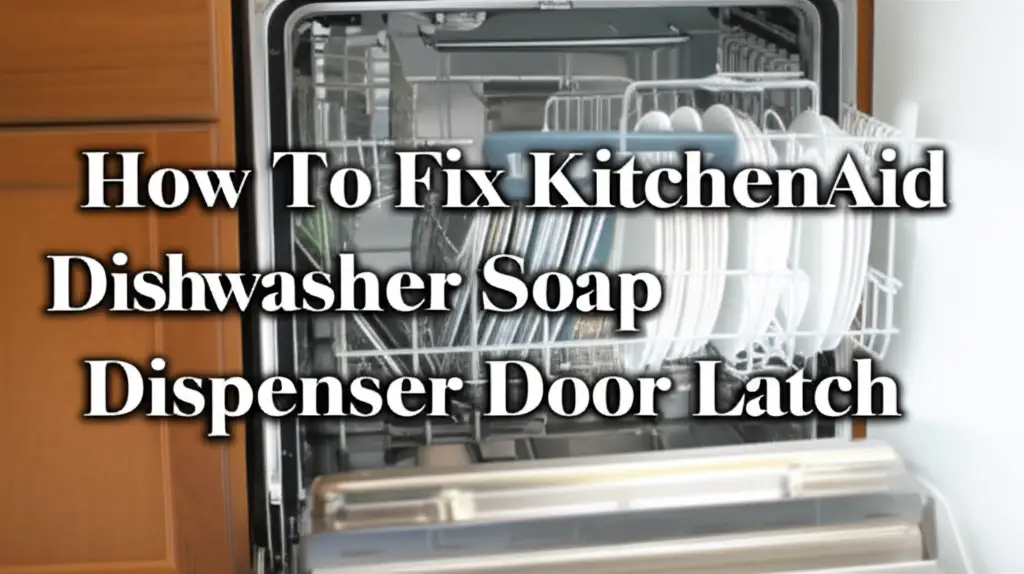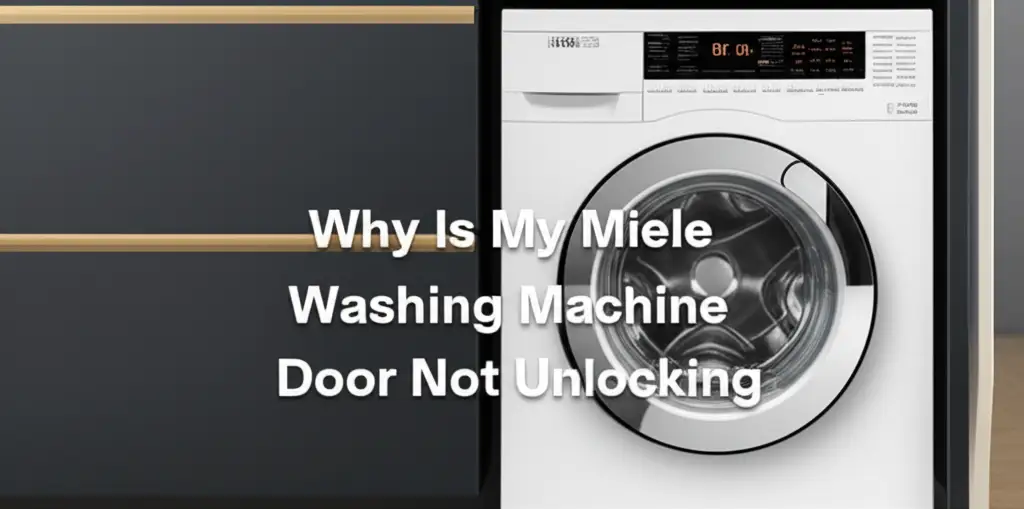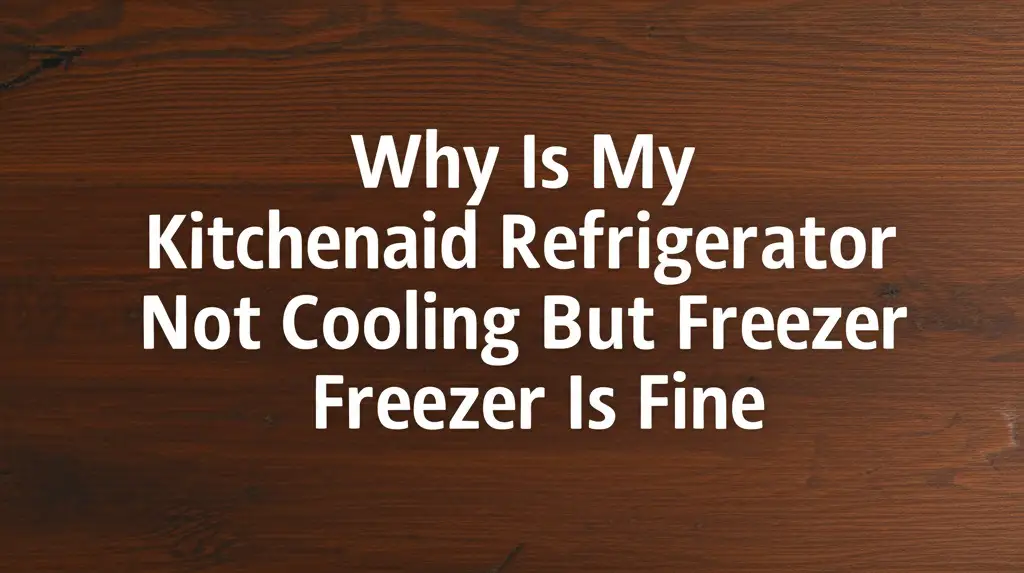· Todd Martin · Home Appliance Repair · 21 min read
How To Fix Kitchenaid Dishwasher Soap Dispenser Door Latch

Fix KitchenAid Dishwasher Soap Dispenser Door Latch
Your KitchenAid dishwasher is a reliable partner in the kitchen. It makes daily chores easy. However, what happens when the soap dispenser door fails to open? A malfunctioning soap dispenser door latch prevents detergent from releasing during the wash cycle. This leaves your dishes dirty. I understand your frustration when this common issue occurs. It disrupts your cleaning routine.
This guide helps you fix a KitchenAid dishwasher soap dispenser door latch. We will look at common reasons why the latch sticks or breaks. You will learn to identify the problem. I will provide clear, actionable steps for troubleshooting and repair. This article empowers you to restore your dishwasher’s performance. Get ready to tackle this repair with confidence.
Takeaway:
- Diagnose the issue: Determine if the latch is stuck, obstructed, or physically broken.
- Clean thoroughly: Often, detergent buildup causes the latch to stick.
- Inspect components: Check the spring, cam, and solenoid for damage.
- Replace faulty parts: Order specific KitchenAid parts if components are broken.
- Prevent future issues: Use proper detergent amounts and clean regularly.
Clear, Concise Answer:
To fix a KitchenAid dishwasher soap dispenser door latch, first check for detergent buildup or obstructions. Clean the dispenser thoroughly. If the latch is still stuck or broken, inspect the spring, cam, and solenoid for damage. Replace any faulty components, following manufacturer guidelines for disassembly and reassembly.
Understanding Your KitchenAid Dishwasher Dispenser
The soap dispenser on your KitchenAid dishwasher plays a crucial role. It holds and releases detergent at the correct time during a wash cycle. This ensures your dishes get clean. The dispenser has a door that opens to release detergent. A latch mechanism holds this door closed. This latch is vital for the dispenser’s function.
The dispenser typically has two compartments. One holds the main wash detergent. The other holds rinse aid. The latch mechanism is specifically for the main wash detergent door. When the dishwasher starts, an electrical signal activates the latch. This releases the door. The detergent then mixes with water. If the latch does not work, the detergent stays in the dispenser. This leaves your dishes dirty.
Knowing how the dispenser works helps you troubleshoot. The door latch is a simple but important component. It often involves a spring and a small arm that moves to release the door. Sometimes, a solenoid is part of the system. This solenoid receives the electrical signal. It pulls the latch arm back, allowing the door to swing open.
Many factors can affect the latch. Detergent type, water temperature, and proper loading all play a part. Understanding these basics prepares you for troubleshooting. A working dispenser means clean dishes every time. I always make sure to check mine before starting a cycle.
Diagnosing the Latch Problem: Common Signs
You need to identify the exact problem with your KitchenAid dishwasher soap dispenser door latch. Proper diagnosis saves time and effort. Several signs point to a latch issue. The most obvious sign is finding detergent still in the dispenser after a wash cycle. The door may not have opened at all.
Sometimes, the door opens only partially. This means some detergent releases. However, not enough gets into the wash. You might also notice a clicking sound, but the door does not open. This sound indicates the solenoid is trying to activate the latch. The latch itself might be stuck. You may try to open the door manually. If it feels stiff, or does not move at all, the latch is likely obstructed.
Visual inspection is very important here. Look closely at the dispenser door and the latch area. You might see dried detergent buildup. This hardened residue can physically block the latch mechanism. It prevents movement. Sometimes, small food particles or other debris get trapped. This can also stop the door from opening.
Check for any visible damage. Look for broken plastic pieces on the latch arm. The spring connected to the latch might be stretched or detached. These physical damages prevent the door from staying closed or opening properly. By carefully observing these signs, you pinpoint the problem area. I always start with a thorough visual check. It helps me narrow down the possibilities quickly. Understanding why your dishwasher tablet might not be coming out of the dispenser can offer additional insights into related issues.
Essential Tools and Safety Precautions
Before you begin any repair on your KitchenAid dishwasher, gather the right tools. You also must prioritize safety. Having the correct tools makes the job easier and prevents damage. Safety precautions protect you from injury. I always make sure my workspace is clear and well-lit.
Here is a list of tools you might need:
- Screwdriver set: You will need Phillips head and flathead screwdrivers. These are for removing panels and small screws.
- Pliers: Needle-nose pliers are useful for gripping small parts. They can help with springs or wires.
- Multimeter: This is helpful for testing electrical components like the solenoid.
- Small brush or old toothbrush: For cleaning dried detergent and debris.
- Soft cloth or sponge: For wiping surfaces clean.
- Work gloves: To protect your hands.
- Safety glasses: To protect your eyes from debris or detergent.
Safety is paramount when working with appliances. Always disconnect power to the dishwasher before starting any repair. Locate the circuit breaker for your kitchen and turn it off. You can also unplug the dishwasher from the wall outlet. This prevents electrical shock. Water is also present in dishwashers. Be careful of any residual water. Have a towel ready for spills.
Work slowly and carefully. Do not force any parts. If a screw feels stuck, check if you missed something. Refer to your dishwasher’s user manual or service manual if you have it. These provide specific diagrams and instructions for your model. I always double-check that the power is off. This simple step protects me from serious harm.
Step-by-Step Guide to Fixing a Stuck Latch
A common issue with a KitchenAid dishwasher soap dispenser is a stuck latch. This often happens due to detergent buildup or minor obstructions. Fixing this usually does not require replacing parts. It involves thorough cleaning and careful inspection. I have fixed this issue many times myself.
Here is how you can address a stuck latch:
- Disconnect Power: This is the most important first step. Turn off the circuit breaker for your dishwasher. Unplug the appliance from the wall outlet. Confirm the power is off before proceeding.
- Open Dishwasher Door: Fully open the dishwasher door. You need clear access to the soap dispenser.
- Inspect the Dispenser: Look closely at the dispenser door and the latch mechanism. You will likely see dried detergent, food particles, or mineral deposits. These residues can cause the latch to bind.
- Clean the Latch Area: Use a small brush, an old toothbrush, or a cotton swab. Dip it in warm water. Gently scrub the latch area. Focus on the moving parts and crevices. Remove all visible residue. You can also use a mild degreaser or white vinegar. This helps dissolve stubborn buildup. Ensure you get into all the tiny spaces around the latch.
- Test the Latch Manually: Once clean, try to move the latch arm with your finger. It should move freely. The dispenser door should click open easily. If it still sticks, repeat the cleaning process. Pay extra attention to any hidden gunk.
- Check for Obstructions: Sometimes, a small piece of plastic or a food particle gets wedged in the mechanism. Use needle-nose pliers or tweezers to carefully remove any foreign objects. Be gentle to avoid bending or breaking components.
- Run a Test Cycle (Empty): Close the dishwasher door. Restore power to the appliance. Run an empty rinse cycle or a short wash cycle. Do not add any detergent. This helps flush out any remaining residue. It also confirms the door opens properly.
- Re-evaluate: After the test cycle, check the dispenser. If the door opens, you have fixed the problem. If it still does not open, the issue might be more complex. It could involve a broken component.
A stuck latch often indicates you might be using too much detergent. Or perhaps your water is very hard. Consider how much dish soap you should use in the dishwasher for optimal performance. Regularly cleaning the dispenser can prevent this issue from recurring. This simple cleaning can often bring your dispenser back to full function.
Addressing a Broken Latch or Spring Mechanism
If cleaning does not resolve the issue, your KitchenAid dishwasher soap dispenser door latch might be broken. This often means a physical component is damaged. Common culprits include a broken plastic latch arm, a stretched or detached spring, or a faulty solenoid. Repairing these requires component replacement. I have replaced these parts on various dishwashers before.
Here is how to address a broken latch or spring:
- Disconnect Power: As always, safety first. Turn off the power to your dishwasher. Unplug it from the wall.
- Access the Dispenser Assembly: You usually need to remove the inner door panel to access the dispenser’s internal components.
- Remove Screws: Open the dishwasher door fully. Look for screws around the inner perimeter of the door. These often hold the inner and outer door panels together. Some models may have screws on the top edge or sides of the door.
- Separate Panels: Carefully separate the inner door panel from the outer panel. The dispenser unit is usually attached to the inner panel. You may need to gently pry the panels apart. Be careful not to damage wiring or seals.
- Locate the Dispenser: The soap dispenser unit will be visible on the inner door panel. It is usually held in place by more screws or clips.
- Inspect Latch Components:
- Latch Arm: Examine the plastic latch arm. It is the piece that physically holds the dispenser door closed. Look for cracks, breaks, or excessive wear.
- Spring: Check the small spring connected to the latch arm. It provides tension to the latch. Is it stretched, broken, or detached from its mounting points? A weak spring prevents the latch from retracting properly.
- Solenoid (if present): Many KitchenAid models use a solenoid to activate the latch. This is a small electromagnetic device. It has wires connected to it. When energized, it pulls a plunger, which in turn moves the latch arm. Look for burnt wires or physical damage to the solenoid body.
- Testing the Solenoid: If you suspect the solenoid is faulty, you can test it with a multimeter. Set the multimeter to measure resistance (Ohms). Disconnect the solenoid wires. Place the multimeter probes on the solenoid terminals. A working solenoid will show a specific resistance reading (usually between 40-100 Ohms, check your service manual). No reading or a very high reading indicates a faulty solenoid. If you are not comfortable with electrical testing, skip this step and consider replacing it if other parts are fine.
- Order Replacement Parts: Once you identify the broken component (latch arm, spring, or solenoid), you need to order the correct replacement part.
- Find your dishwasher’s model number. This is usually on a sticker inside the door frame.
- Use the model number to search for “KitchenAid dishwasher soap dispenser latch kit” or “KitchenAid dispenser solenoid” online. Many appliance parts suppliers stock these.
- Replace the Broken Part:
- Spring: If only the spring is broken, carefully unhook the old spring and install the new one. Use needle-nose pliers for this.
- Latch Arm/Mechanism: If the latch arm or the entire latch mechanism is integrated, you may need to remove a few small screws that secure it to the dispenser housing. Install the new part in the exact same orientation.
- Solenoid: Disconnect the old solenoid’s wires. Remove any screws or clips holding it in place. Install the new solenoid. Reconnect the wires securely. Ensure proper polarity if marked.
- Reassemble the Dishwasher:
- Carefully reattach the dispenser assembly to the inner door panel.
- Align the inner door panel with the outer panel. Secure it with all the screws you removed earlier. Do not overtighten.
- Ensure all wires are tucked away and not pinched.
- Test the Repair: Restore power to the dishwasher. Run an empty cycle without detergent. Observe if the dispenser door opens smoothly during the wash cycle. A properly functioning latch means a successful repair.
Replacing parts requires some patience. It is a straightforward process for most DIYers. If you are replacing a solenoid, it is also good to understand how other parts of a dishwasher door work, like where the door switch is on a dishwasher, as this system also controls cycle initiation. I recommend taking pictures as you disassemble. This helps with reassembly.
Preventing Future Dispenser Latch Issues
Preventing future problems is always better than fixing them. Several practices help you avoid a stuck or broken KitchenAid dishwasher soap dispenser door latch. These tips focus on proper usage and routine maintenance. I follow these rules to keep my appliances running smoothly.
Here are key preventive measures:
- Use the Right Amount of Detergent: Overfilling the dispenser is a common cause of buildup. Excess detergent can harden and gum up the latch mechanism. Follow the detergent manufacturer’s recommendations. Use less if you have soft water. If you want to know more, explore how much dish soap you can use in the dishwasher.
- Use High-Quality Detergent: Cheap or low-quality detergents can leave more residue. They may not dissolve completely. Invest in reputable dishwasher detergents, especially those with good cleaning agents. This minimizes residue.
- Use Rinse Aid Regularly: Rinse aid helps water sheet off dishes. It prevents water spots and aids drying. Crucially, it helps prevent detergent and mineral deposits from forming on the dispenser. It also ensures the detergent compartment dries properly.
- Clean the Dispenser Regularly: Make it a habit to wipe down the soap dispenser. Do this after each wash cycle. Use a damp cloth to remove any fresh residue. Perform a deeper clean monthly. Use a small brush and warm water. This removes any developing buildup.
- Pre-Rinse Heavily Soiled Dishes: While modern dishwashers handle most food scraps, excessive food can fall into the dispenser. Large food particles can obstruct the latch. Scrape off large food particles before loading dishes.
- Avoid Blocking the Dispenser: When loading your dishwasher, ensure no dishes or utensils block the dispenser door. If the door cannot open fully, the detergent will not release. It can also put stress on the latch mechanism. This can cause damage over time.
- Check Water Hardness: Hard water contains minerals that can contribute to buildup. If you have hard water, consider using a dishwasher cleaner specifically designed for mineral removal. You might also need a water softener. This reduces mineral deposits throughout your dishwasher, not just the dispenser.
- Run Hot Water Before Starting: Before you start the dishwasher, run the hot water in your kitchen sink for a minute. This ensures hot water fills the dishwasher from the beginning of the cycle. Hot water helps dissolve detergent more effectively. This reduces the chance of residue.
These simple steps make a big difference. They extend the life of your KitchenAid dishwasher’s soap dispenser. They also keep your dishes sparkling clean. I always tell my friends about these easy maintenance tips.
When to Consider Professional Help
While many KitchenAid dishwasher soap dispenser latch issues are DIY-friendly, some situations warrant professional help. Knowing when to call a technician saves you time, frustration, and potential further damage. I know my limits when it comes to appliance repair.
Here are scenarios where professional help is advisable:
- Lack of Experience or Confidence: If you are uncomfortable with electrical components, disassembling appliances, or precise mechanical work, a professional is your best bet. It is safer to let an expert handle it. Attempting repairs beyond your skill level can lead to more costly damage.
- Complex Electrical Issues: If you suspect a problem with the dishwasher’s main control board or wiring, do not attempt to fix it yourself. These components carry significant electrical risk. They also require specialized diagnostic tools. A malfunctioning control board could send incorrect signals to the dispenser.
- Dispenser Not Getting Power: If the solenoid tests fine, but the dispenser still does not activate, the issue might be with the dishwasher’s internal wiring or control system. This is a job for a qualified appliance technician. They can trace electrical paths and diagnose control board failures.
- Repeated Latch Failures: If you have fixed the latch multiple times and the problem keeps recurring, there might be an underlying issue. This could be a design flaw, chronic hard water problems, or a larger system malfunction. A professional can provide a more comprehensive diagnosis.
- Difficulty Finding Parts: Some older KitchenAid models might have discontinued parts. A technician often has access to a wider network of parts suppliers. They might also suggest suitable generic replacements if original parts are unavailable.
- Under Warranty: If your KitchenAid dishwasher is still under warranty, attempting a DIY repair might void it. Check your warranty terms. Contact KitchenAid customer service or an authorized service provider. They can arrange a repair without voiding your coverage. You can find out more about how long the warranty is on a KitchenAid dishwasher to make an informed decision.
- Other Dishwasher Problems: If the dispenser latch issue is one of several problems you are experiencing (e.g., KitchenAid dishwasher leaking from the bottom of the door or water in the bottom of the dishwasher), it might indicate a more serious underlying fault. A professional can assess all issues holistically.
Always get estimates from a few reputable technicians. Ask about their experience with KitchenAid appliances. A professional repair can extend the life of your dishwasher. It ensures proper operation. Do not hesitate to call for help when you need it.
Troubleshooting Dispenser Issues Beyond the Latch
Sometimes, the dispenser door latch works perfectly, but the detergent still does not release. This indicates other components of the KitchenAid dishwasher soap dispenser are at fault. It is important to look beyond just the latch mechanism. I have seen this happen often, where the latch is fine, but something else is wrong.
Here are other issues to troubleshoot:
- Faulty Solenoid: Even if the latch arm moves freely, the solenoid might not be activating correctly. This happens if the solenoid coil is burnt out or has an open circuit. Test the solenoid with a multimeter as described earlier. If it shows no resistance, it is faulty. The solenoid is the electrical component that pulls the latch arm open.
- Wiring Problems: The wires leading to the solenoid or the dispenser assembly could be loose, corroded, or broken. Check all wire connections. Ensure they are secure. Look for any visible damage to the wire insulation. A loose connection prevents the electrical signal from reaching the solenoid.
- Control Board Malfunction: The dishwasher’s main control board sends the signal to the dispenser solenoid. If the control board is faulty, it might not send this signal. This is a complex issue. It often requires professional diagnosis and replacement. Signs of a failing control board can include other erratic behaviors from the dishwasher. For example, your KitchenAid dishwasher’s clean light might be blinking.
- Dispenser Cover Gasket Issues: The detergent dispenser often has a rubber gasket or seal around its opening. If this gasket is damaged or worn, water can get into the dispenser prematurely. This causes the detergent to clump. It prevents proper release. Check the gasket for tears, cracks, or hardening.
- Detergent Quality or Age: Detergent can degrade over time. Old or clumpy detergent might not dissolve properly. It could stick in the dispenser. Ensure you use fresh, high-quality detergent. Powder detergents can sometimes absorb moisture and clump. Consider switching to gel or pod detergents if this is a recurring issue.
- Water Temperature: The water inside your dishwasher needs to be hot enough for detergent to dissolve effectively. If your hot water supply is not sufficient, detergent might not release or dissolve. Ensure your water heater is set to at least 120°F (49°C). Run the hot water tap in the sink before starting a cycle.
- Water Inlet Valve: If insufficient water enters the dishwasher, the spray arms might not effectively rinse out the detergent. A partially clogged or failing water inlet valve could be the cause. This might also lead to issues like water remaining in the bottom of your KitchenAid dishwasher.
Troubleshooting these issues often involves disassembling the inner door panel. This gives you access to the dispenser’s internal workings. Always disconnect power first. A systematic approach helps you pinpoint the exact problem. I always check the simplest possibilities first before moving to more complex ones.
Maximizing Dishwasher Performance After Latch Repair
After successfully fixing your KitchenAid dishwasher soap dispenser door latch, you want to ensure your appliance continues to perform at its best. Proper post-repair care and general maintenance are important. These steps help you get the cleanest dishes. They also prolong your dishwasher’s lifespan. I always do a few things after a repair to confirm everything is perfect.
Here are ways to maximize your dishwasher’s performance:
- Run a Self-Clean Cycle: After any repair, especially one involving the detergent dispenser, run a self-clean cycle. Some dishwashers have a dedicated self-clean option. If not, run an empty cycle on the heaviest setting with a dishwasher cleaning tablet. This helps flush out any remaining residue or debris from the repair process.
- Verify Detergent Dispensing: For the next few wash cycles, pay close attention to the soap dispenser. Ensure the door opens fully. Check that all detergent releases. This confirms your repair was successful and stable.
- Optimize Detergent Usage: Now that your dispenser works, use the correct amount of detergent. Avoid overfilling. Too much detergent creates excessive suds. This can reduce cleaning effectiveness. It also leaves a residue on dishes. Refer to your detergent’s instructions. Adjust for your water hardness.
- Use Rinse Aid Consistently: Rinse aid is not just for preventing spots. It also helps the dishwasher dry better. It aids in sheeting water away from the dispenser. This keeps the dispenser drier. This prevents future buildup that could affect the latch. Keep the rinse aid dispenser full.
- Clean the Filter Regularly: A clogged filter restricts water flow. This impacts cleaning performance. It can also lead to detergent not dissolving properly. Locate your dishwasher’s filter. Clean it weekly or bi-weekly. Remove any food particles. This simple step keeps your dishwasher efficient.
- Load Dishes Correctly: Proper loading ensures water and detergent reach all items. It prevents dishes from blocking the spray arms or the dispenser. Make sure tall items do not obstruct the dispenser door. This allows the door to open freely.
- Maintain Hot Water Supply: Ensure your hot water heater is set to an adequate temperature (around 120-140°F). Hot water is crucial for activating detergent enzymes and dissolving tough grease. Running the kitchen sink’s hot water before starting the dishwasher also helps.
- Periodically Deep Clean the Dishwasher: Even with regular use, mineral deposits and grime can accumulate. Use a specialized dishwasher cleaner once a month or every few months. This removes buildup in hard-to-reach areas. This includes the spray arms, walls, and heating element.
By following these tips, you not only ensure the soap dispenser latch stays fixed, but you also enhance your KitchenAid dishwasher’s overall cleaning power. My dishes are always sparkling clean when I follow these maintenance steps.
Frequently Asked Questions
Q1: Why does my KitchenAid dishwasher soap dispenser door not open during a cycle?
A1: The most common reason is dried detergent buildup around the latch mechanism. This prevents the door from opening. Other causes include a broken latch spring, a faulty solenoid, or obstructions like food particles. Always check for buildup first.
Q2: Can I fix a broken KitchenAid dishwasher soap dispenser latch myself?
A2: Yes, many soap dispenser latch issues are DIY-friendly. Cleaning detergent buildup is simple. Replacing a broken spring or solenoid is also possible for someone with basic tools and some mechanical aptitude. Always disconnect power first.
Q3: What tools do I need to repair a dishwasher soap dispenser latch?
A3: You will typically need a screwdriver set (Phillips and flathead), needle-nose pliers, and possibly a small brush or old toothbrush for cleaning. A multimeter is useful for testing the solenoid. Safety gloves and glasses are also recommended.
Q4: How do I prevent detergent from sticking in the dispenser?
A4: Use the correct amount of detergent, avoid overfilling, and use a high-quality product. Regularly clean the dispenser. Using rinse aid helps prevent buildup. Ensure proper water temperature and avoid blocking the dispenser with dishes.
Q5: Is it safe to use my KitchenAid dishwasher if the soap dispenser latch is broken?
A5: You can use the dishwasher, but your dishes will not get clean because detergent will not release. It is best to fix the latch before running cycles. Continuously using a broken dispenser may put stress on other components or waste water and energy.
Q6: How do I test the solenoid on my KitchenAid dishwasher dispenser?
A6: Disconnect power to the dishwasher. Access the solenoid, usually by removing the inner door panel. Disconnect the solenoid’s wires. Use a multimeter set to ohms to test resistance across its terminals. A working solenoid will show a specific resistance value (e.g., 40-100 ohms). No reading indicates a fault.
Conclusion
A malfunctioning soap dispenser door latch on your KitchenAid dishwasher is a common but solvable problem. I hope this comprehensive guide has given you the confidence and knowledge to tackle this repair. We have explored the mechanics of the dispenser, diagnosed common issues, and provided detailed steps for cleaning and replacing faulty components. Remember, proper diagnosis is key. Start with simple solutions like cleaning before moving to part replacement.
Always prioritize safety by disconnecting power before starting any work. Regular maintenance and proper detergent use will help prevent future issues with your KitchenAid dishwasher soap dispenser door latch. If the repair seems too complex, or if you encounter persistent problems, do not hesitate to consult a professional technician. Your dishwasher is an essential home appliance. With these tips, you can ensure it continues to deliver sparkling clean dishes for years to come.
- KitchenAid dishwasher
- soap dispenser repair
- dishwasher latch fix
- appliance troubleshooting
- DIY dishwasher repair





